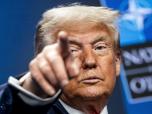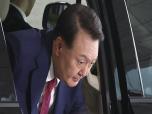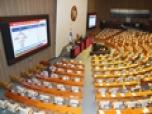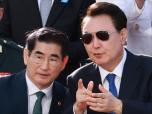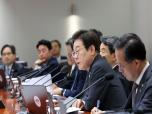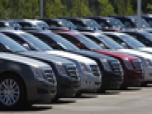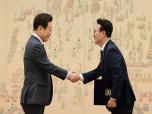재정부-금융위, '<FT>와의 전쟁' 선언
<FT> "아시아에서 한국만 외환위기 직면"에 강력 반발
<FT> "아시아에서 한국만 외환위기 직면"
<FT>는 이날자 '침몰감(Sinking feeling)'이란 제목의 한국경제 분석기사를 한면에 걸쳐 할애한 뒤, 지난 97~98년 금융위기를 겪은 아시아 국가들이 대체로 경상수지 흑자나 은행들의 안정적 자본구조 등을 바탕으로 잘 견뎌내고 있지만, 한국만 유독 달러화 환율이 10년만에 최저치로 떨어지면서 외환보유고가 고갈될 위기에 직면했다고 보도했다.
<FT>는 이어 급기야 강만수 기획재정부장관과 포스코 등 민간기업이 달러 구하기에 나서고 일부 정치인들은 애국심에 호소하고 있다고 전했다. <FT>는 또 강만수 장관이 국회에서 "투자, 소비, 실업률, 경상수지 적자 등 수출을 제외한 모든 것이 외환위기와 비슷하다"고 답변했다고 덧붙이기도 했다.
<FT>는 이어 환율 폭등으로 고통받는 기러기아빠 등의 어려움을 상세히 전한 뒤, 한국경제의 문제점으로 ▲매우 취약해지고 있는 외환유동성 ▲주택 구입에 따른 과도한 가계부채 ▲은행들의 예금 대비 높은 대출 비율 ▲ 명목상 4천억달러 가량의 외채 규모 등을 열거한 뒤, ▲경상수지 악화 ▲주요국의 수요 감소에 따른 수출 감소 우려 ▲중소기업 부문의 경기 위축 등도 향우 어려움을 가중시킬 수 있는 요인으로 지목했다.
UBS의 아시아 책임 이코노미스트인 던컨 울드리지는 "한국은 이번 위기를 이겨낼 것이지만 상처는 있을 것"이라며 "나의 보다 큰 관심은 한국의 신용거품 파열이다. 많은 사람들이 신용 거품의 위험을 인식하지 못하는 듯 하다"며 향후 부동산거품 파열 등에 대한 우려를 제기했다.
재정부-금융위 긴급기자회견 갖고 "<FT> 보도 사실무근"
기획재정부, 금융위원회, 금융감독원은 이날 오후 공동으로 작성한 보도 해명자료를 배포하는 동시에 기자 브리핑을 통해 <FT> 보도를 조목조목 반박했다.
정부는 우선 강만수 장관이 달러를 구하기 위해 씨티와 모건스탠리 대표이사(CEO)를 만날 예정이라는 <FT>와 관련, 사실무근이라며 강 장관이 14일(현지시간) 스티븐 로치 모건스탠리 수석 이코노미스트와 로버트 루빈 씨티그룹 이사(전 미국 재무장관)를 면담할 예정이나 이는 주로 글로벌 금융위기의 향방과 대응 등에 대해 논의하기 위한 자리라고 반박했다.
정부는 또 포스코가 10억 달러 규모의 채권을 발행키로 한 것도 FT의 보도처럼 환율 안정을 위한 것이 아니라 해외원료 확보와 대우조선해양 인수를 위한 자금확보 차원으로 자체 결정한 것이라고 주장했다.
정부는 또 '최근 환율의 급격한 상승으로 위기감이 조성됐고, 외환보유액이 고갈될 위험에 있다'는 보도내용과 관련, "최근 환율은 대외여건의 악화와 이에 따른 심리불안까지 가세하여 1,400원대까지 근접했으나 글로벌 금융시장 안정기대 및 단기 급등에 대한 조정 등으로 1,200원대 초반으로 하락하면서 안정세를 보이고 있다"며 "또 현재 한국의 외환보유액 수준은 충분한 수준"이라고 밝혔다.
정부는 '높은 예대율로 자금조달의 12% 정도를 해외시장에 의존하고, 은행 조달금리와 정책금리 간 차이가 확대되는 등 유동성이 축소되고 있다'는 보도내용과 관련, "2008년 9월 말 현재 국내은행 예대율(CD 포함)은 103.2% 수준(일본 74%, 미국 112%)으로 크게 높지 않은 수준"이라며 "원화 유동성 비율도 2008년 8월 말 현재 107.7%로서 감독당국의 지도비율(100%)을 상회하는 양호한 수준"이라고 반박했다.
정부는 한국 시중은행들이 외화를 빌어다가 원화 대출을 해주다가 외환유동성 위기에 직면했다는 보도에 대해 "은행들의 외화자금조달(6월말 외화부채/총부채비율 13.7%) 목적은 국내 중소기업 등에 대한 원화대출 목적이 아니라 외화대출, 외화증권 매입 등 외화자산(외화자산/총자산비율 12.7%) 운용을 위한 것"이라고 반박했다.
정부는 또 한국의 민간부문 부채가 국내총생산(GDP)의 180%에 달하는 등 지나치게 과도하다는 <FT> 지적에 대해서도 가계의 금융자산도 함께 증가하고 있어 우려할만한 수준이 아니라고 반박했다.
현재 가계부채는 740조원으로 작년 기준 GDP 대비 82%, 기업부채는 940조원으로 GDP 대비 104% 수준이나, 가계부문 금융자산은 부채의 2.2배로 자산으로 부채를 상환할 수 있고 기업부문의 GDP 대비 부채비율도 1997년 131%에서 낮아지는 추세라는 게 정부 주장이다.
정부는 '투자, 소비, 실업률, 경상수지 적자 등 수출을 제외한 모든 것이 외환위기와 비슷하다고 강만수 장관이 국회에서 답변했다'는 보도내용에 대해서도 "지난 7월 당시는 대외여건 악화와 함께 촛불시위, 파업 등으로 사회적 혼란이 가중되는 상황이었는데 장관의 발언은 어려운 경제상황에 대한 국민들의 냉철한 인식과 고통극복에 대한 동참이 없다면 매우 어려운 상황으로 악화될 수 있다는 우려를 밝힌 것"이라며 "답변 후 'IMF와 같은 그런 위기로 갈 것인가에 대해서 정부로서는 그렇게는 생각하고 있지 않다'고 후반부에서 밝힌 것처럼 현재 우리 경제 상황이 외환위기와 유사하다는 의미가 아니다"라고 반박했다.
정부는 '경상수지가 외환위기 이후 최초로 적자로 전환됐고, 수출이 GDP의 40%를 기여하기 때문에 글로벌 수요감소시 우려가 된다'는 보도와 관련, "금년 경상수지 적자전환 요인은 유가상승 때문"이라며 "유가상승 효과를 제외하면 경상수지 흑자가 가능하다. 4.4분기 경상수지는 유가하락, 연말 해외수요에 따른 수출호조 등에 힘입어 흑자를 기록할 전망"이라고 강조했다.
정부 반박은 <FT>의 기사중 과장된 대목을 지적한 것이나, <FT> 보도내용중 강만수 장관이 지난 7월 국회에서 촛불집회 진압을 위해 경제위기론을 증폭시킨 대목 등이 인용된 대목은 이번 위기의 상당부분을 강만수 경제팀이 제공한 것이란 사실을 재차 확인시켜주고 있어 적잖은 파란을 예고하고 있다.
다음은 <FT>의 기사 전문.
Sinking feeling
By Louise Lucas, Song Jung-a and Raphael Minder
Published: October 13 2008 19:46
The global credit crisis is washing up on Asia’s shores. The region, having been through its own devastating financial crisis in 1997-98, remembers many of the lessons that others forgot. By and large, Asia today is a continent of current account surpluses, well-capitalised banks and modestly leveraged balance sheets.
But fault-lines exist. South Korea, which was bailed out by the International Monetary Fund in 1997, has seen its currency plunge to a 10-year low amid a scramble for dollars.
Politicians and the private sector are rallying round. Kang Man-soo, finance minister, is taking his plea for dollars to Wall Street, where he is due to meet executives of banks such as Citigroup and Morgan Stanley. Posco, the steel maker, said last week it would sell $1bn (?730m, ?570m) of bonds overseas as part of efforts to stabilise the won. Employees at Kyunggi NongHyup, a farmers’ bank in greater Seoul, are hunting down dollars so that they can open deposit accounts at the lender – and provide it with foreign funding. The employee who hauls in the most dollars will win a prize.
Lest anyone miss the point that one of the world’s most successful exporting nations is in a bind, Mr Kang recently told a parliamentary session that “apart from exports, everything – including investment, consumption, employment and the current account balance – is showing a trend similar to that seen during the [Asian crisis]”.
‘The amount I need to send is growing’
South Korea’s tumbling currency has brought sleepless nights for Kim Seung-ki, a technology analyst at a Seoul securities house and one of the thousands of kirogi appa, the “geese fathers” who fund their families’ overseas schooling, writes Song Jung-a
Every month Mr Kim changes an ever bigger chunk of his won-denominated salary into dollars, which he duly remits to his wife and two children who migrated to Canada for the young Kims’ education.
“The amount that I have to send them is getting bigger, adding more financial burden. And I am afraid the situation will get worse,” he laments.
More Koreans have been choosing this split existence, as parents and children alike despair of a gruelling school system based on rote learning.
The trend started in the rich districts of southern Seoul but has spread across the country, with many middle-class families joining the trend despite the personal sacrifices and financial costs involved.
Koreans form the largest group of foreign students in the US, with about 73,000 studying there. The number has been growing rapidly, with an American education increasingly seen as a ticket to success in Korea.
The US is the prime destination but cheaper countries such as Canada, Australia and New Zealand are becoming popular alternatives. Last year, nearly 218,000 Koreans were studying at overseas universities and graduate schools, up 36 per cent from four years ago. But the number of children attending school abroad, at around 30,000, has jumped 80 per cent over a similar period.
Although South Koreans are increasingly becoming global consumers of higher educational services, the tumbling won may put a brake on the trend as parents start to feel the pinch. The won has plunged about 24 per cent so far this year to its lowest level in a decade, reminding many South Koreans of the 1997-98 financial crisis, in which the value of the local currency halved. At that time, many parents brought children studying abroad back home, unable to meet the cost.
“I still don’t want to bring them back, although it is getting more difficult,” says Mr Kim. “But I may have to if the situation gets worse.
South Korea’s problems look scarily familiar. Like the US, its consumers and companies have taken on too much debt. Like banks in the US and UK, Korean lenders rely on wholesale markets for funding – and with global credit markets clammed up, they are left in the same position: between a rock and a hard place.
South Korea has some $175bn in external short-term debt that has to be rolled over by the end of next June. Of this, perhaps $80bn relates to foreign banks’ onshore branches and can be deducted (on the assumption that the banks’ head offices will make dollars available). It is the balance that has Korean policymakers sweating at night – and which lies behind the pleas for access to dollar credit lines.
In a worst-case scenario, Korea’s foreign exchange trove of $240bn could be deployed. But what makes the position of Korean banks especially precarious is that domestic liquidity too is ebbing. The widening spread between banks’ funding rates and policy rates shows that risk aversion exists on home turf as well.
Hence, perhaps, the appeal to grassroots patriotism. Last week, President Lee Myung-bak (right) lambasted Koreans for not helping stem the won’s tumble. “Some businesses and individuals seem to think they can get rich quickly by hoarding dollars,” he said. “But individual greed should be put aside in times of national crisis.”
Individual greed was put aside in spades in the last crisis, when housewives brought necklaces and wedding rings to be melted down in order to repay foreign debt. This time, that may not be possible. Korean consumers tend to have more debts than baubles, a result of a push into home ownership. Indeed, levels of indebtedness in Korea are enough to make the average American blush: private sector debt stands at 180 per cent of gross domestic product.
Reliance on overseas markets has increased too. Banks rake in 12 per cent of their funding from overseas, according to Moody’s Investors Service. Wholesale markets are more important than in most of the rest of Asia, where banks generally have far more deposits than they can lend on to borrowers. In Korea, by contrast, the loan-to-deposit ratio is about 124 per cent. For the big four banks, adjusted loan-to-deposit ratios rose to 150-180 per cent in the second quarter, according to Moody’s. The rating agency changed its outlook on the four to negative this month.
“The liquidity squeeze is serious, and an obvious concern is that it may evolve into an issue of solvency,” says James McCormack, head of Asia-Pacific sovereign ratings at Fitch Ratings.
Elsewhere on the checklist for vulnerability, South Korea ticks several boxes. It has high external debt. Short- and long-term borrowing totals $400bn, above the levels at the time of the last crisis both in nominal terms and as a percentage of GDP.
The current account balance has teetered into the red, for the first time since the crisis of 1997-98. Portfolio capital flows into the country are susceptible to swift changes of direction – foreigners have been net sellers of the stock market in each of the past four years, for example. The economy, which Mr Lee pledged would grow by 7 per cent a year, is instead decelerating sharply and is this year expected to expand by a modest 4.7 per cent.
Arguably, this time around, Korea could be seen as a victim of its own success. On a macroeconomic level, a country that derives 40 per cent of its GDP from exports will now have to cope with dwindling western demand for its products. Companies such as Samsung and LG supply consumers worldwide with goods ranging from computer chips and mobile phones to televisions and fridges. Korea is also the world’s leading shipbuilding nation, with unchallenged expertise in the manufacturing of advanced vessels such as liquefied gas carriers. Hyundai, meanwhile, has built the world’s largest car manufacturing centre in its southern fiefdom of Ulsan, using a dedicated deep-water port to ship out 1m vehicles a year.
Beyond such household names, the country’s small- and medium-sized enterprises are often world leaders in niche markets and have come to play a key role in South Korea’s development. SMEs account for 88 per cent of Korea’s employment, half of its manufacturing output and 32 per cent of its exports.
Knock-on effects
Seoul is to help small and midsize enterprises (SMEs) suffering losses from a currency derivative product called kiko (knock-in knock-out).
Kiko contracts set a predetermined range for the won/dollar exchange rate. So long as the won stays within this range – usually 10 per cent – holders can sell at a specified rate. But if the currency moves beyond that, they take a bigger hit than if no derivative contract were in place.
The government estimates that SMEs chalked up W1,285bn ($1.03bn, £591m, ?756m) in losses on the instrument as of the end of August.
Yet this segment is highly vulnerable to a downturn, implying higher unemployment, reduced domestic demand and more bank loans turning bad. “I think Korea will weather this [crisis] but not without some battle wounds,” says Duncan Wooldridge, Asia chief economist at UBS. “I’m much more concerned about the risk of a domestic credit bubble bursting. Many people do not seem to appreciate the risk.”
While the rapidly weakening won should stimulate exports, it again recalls the 1997 crisis and adds to fears about rolling over short-term dollar-denominated debt. It also risks depleting Korea’s formidable foreign currency kitty, the sixth biggest in the world and a key difference between 2008 and 1998, when reserves were a mere $22bn. While the current $240bn gives the Bank of Korea a far bigger buffer, it can still be whittled back – JPMorgan estimates that intervention, on both the spot and futures market, cost $40bn over the past two months.
While the government makes frequent reference to its foreign reserves and insists that the won will stabilise, economists are divided over whether the currency can recover soon, especially in the wake of Korea’s interest rate cut last week.
But it is hard for ordinary Koreans to avoid a sense of panic when the government unveils ever more desperate-sounding measures: on Monday, for example, Mr Lee urged people to ration energy consumption and overseas spending. “If we cut down on energy by 10 per cent, we will not post a current account deficit,” he told radio listeners.
Adding to nervousness is the fact that Koreans have been here before – several times in the past decade. Takahira Ogawa, sovereign analyst at Standard & Poor’s, notes that Korea was among the first Asian economies to recover from the 1997-98 crisis, in part because the government increased the issuance of domestic corporate bonds to companies shut out of international markets. The financial groups accumulating the paper soon ran into difficulties and had to be bailed out by the government.
Still determined to galvanise growth, the government then targeted consumer spending. A cocktail of tax incentives and credit card deregulation prompted a debt-fuelled spending binge – and another burst credit bubble in 2002-03. Hundreds of thousands of Koreans were obliged to file for bankruptcy; several also committed suicide.
The latest slump takes place under the watch of a relatively new, and unpopular, government. “The government has lost its credibility in terms of economic policy, because of its failed handling of currency rates. People don’t seem to trust its policy management capability, which makes the current situation more difficult,” says Huh Chan-gook, a researcher at the Korea Economic Research Institute.
The most immediate concern for Korea, however, is how to unwind the leverage that it has accumulated since the Asian crisis. That will not only be painful for the banks but could also bring the economy to a standstill, given how much of the lending has been handed to SMEs in the form of collateralised loans. Since 60 per cent of these SME loans are supported by government-controlled banks, however, the most likely scenario is a quantum leap in non-performing loans.
Furthermore, while the currency’s fall should normally benefit exporters, it could prove expensive for the many that have taken hedges against currency swings (see above). Two years ago, when the Korean won was steadily appreciating, shipbuilders and others grew worried about the mismatch between rising manufacturing costs and dollar order books stretching for as long as three years. To protect themselves, they bought hedging contracts from banks, which in turn had to go and borrow short-term US currency to offset this additional risk.
For now, Koreans are not running to their banks to withdraw savings and most pundits remain confident that Korea and its banks are sufficiently solid to avoid an Icelandic-style implosion. Some investors, in fact, are already positioning themselves to take advantage of a recovery. Just as it did in the aftermath of the 1998 crisis, when it established its presence in Korea, Oaktree Capital Management, the US private equity fund, is now earmarking $3bn to buy on the cheap once calm returns. “If assets become mispriced, they become more attractive,” says Oaktree’s Asian managing director, Robert Zulkoski.
Alas, if the experience of the west is any guide, it may take some time and angst before that point is reached.
<저작권자ⓒ뷰스앤뉴스. 무단전재-재배포금지>

